Leadership Analysis: Great Man Theory and Contemporary Challenges
VerifiedAdded on 2022/09/18
|11
|3313
|28
Report
AI Summary
This report provides an in-depth analysis of the Great Man theory of leadership, examining its fundamental aspects and its practical application in a contemporary business context. The report begins with an introduction to the theory, explaining its core tenets, such as the belief that leaders are born with inherent traits that distinguish them from others. The report then delves into the key aspects of the theory, including the significance of traits like persuasiveness, courage, and intelligence. A significant portion of the report is dedicated to exploring a contemporary challenge faced by leaders today, specifically focusing on workplace diversity. The report discusses how the Great Man theory can be applied to overcome such challenges, highlighting the importance of communication, understanding, and adapting to diverse perspectives. The analysis includes examples of leaders who exemplify the theory and how their behaviors align with its principles. The report concludes by summarizing the key findings and emphasizing the relevance of the Great Man theory in the modern global business environment.
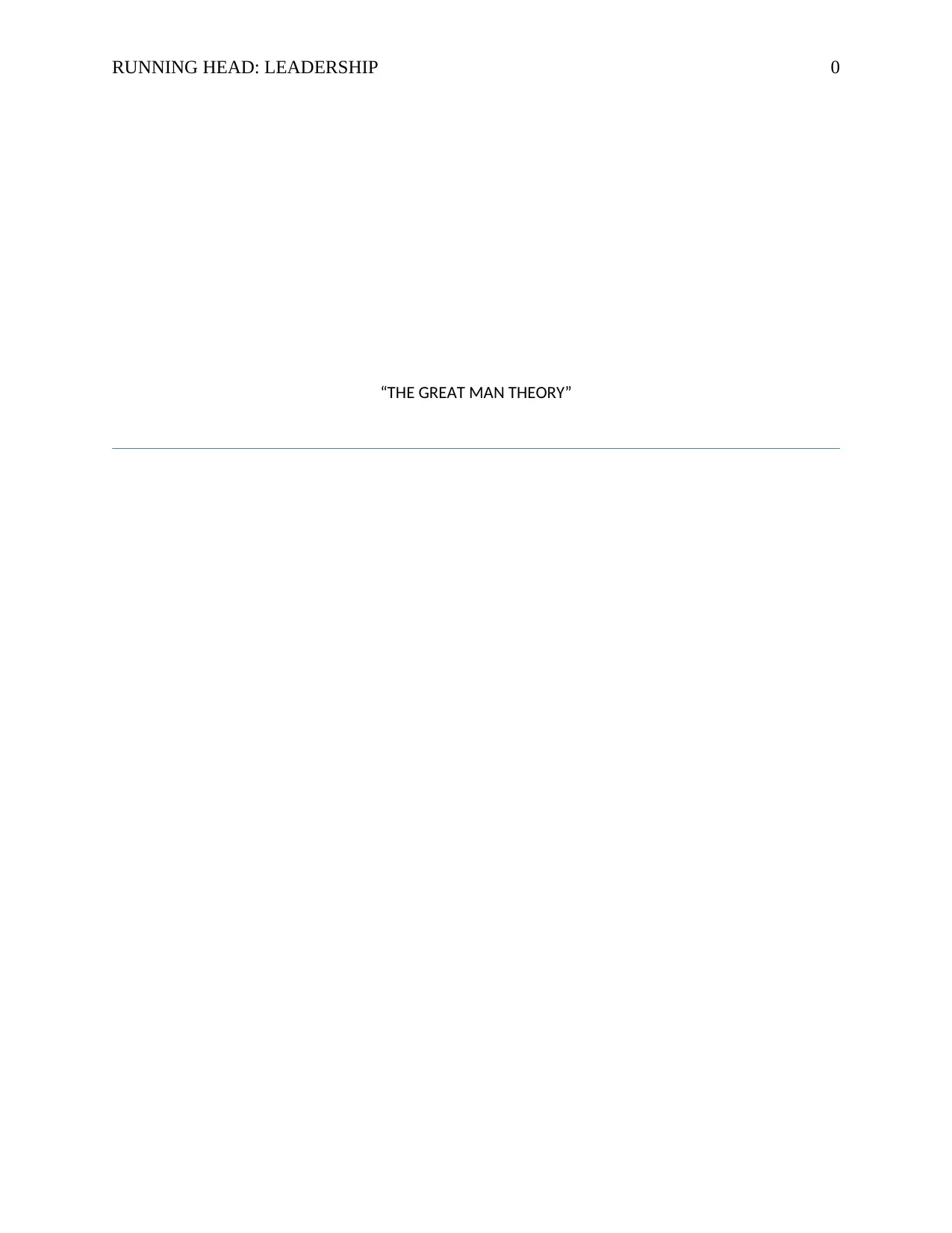
RUNNING HEAD: LEADERSHIP 0
“THE GREAT MAN THEORY”
“THE GREAT MAN THEORY”
Paraphrase This Document
Need a fresh take? Get an instant paraphrase of this document with our AI Paraphraser
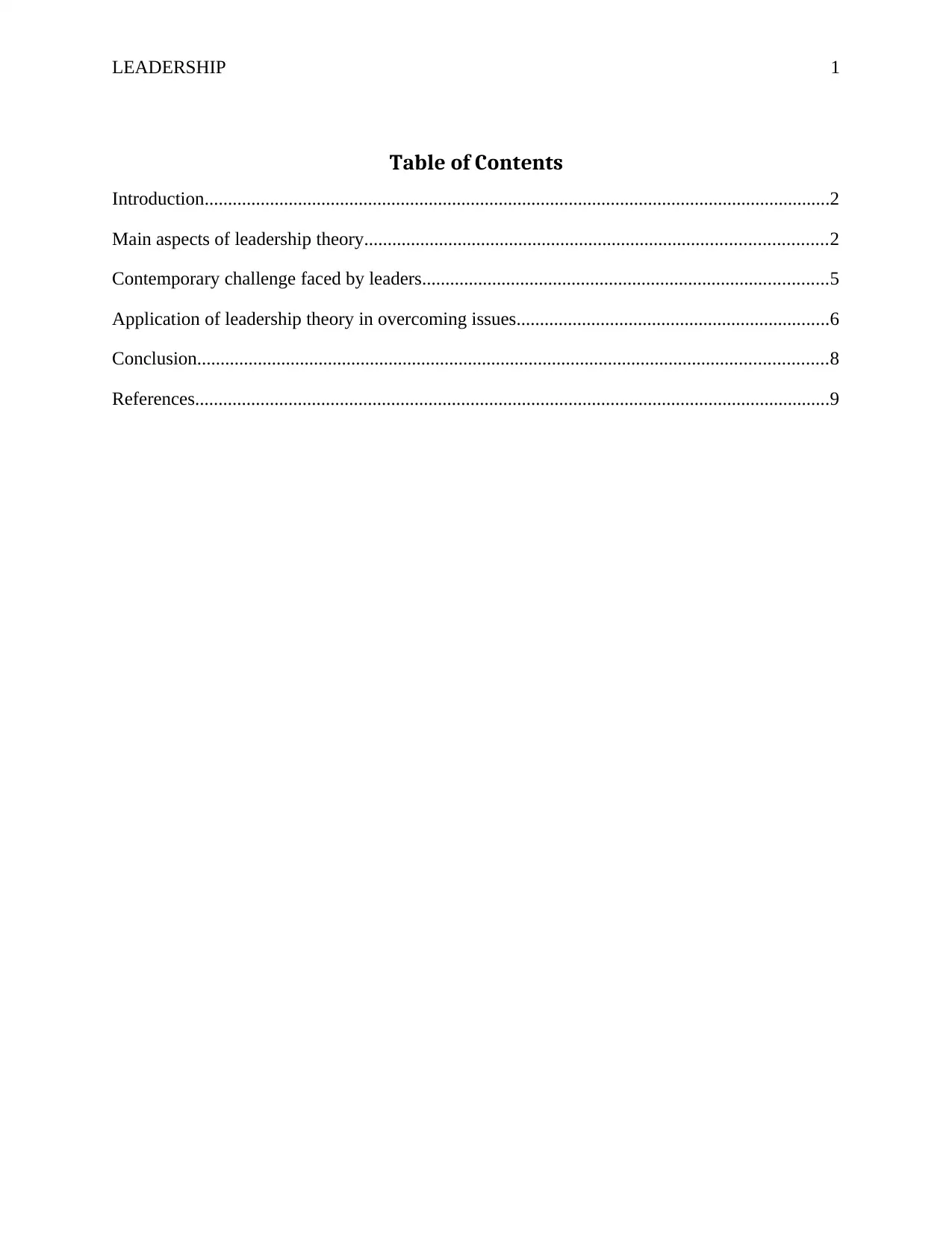
LEADERSHIP 1
Table of Contents
Introduction......................................................................................................................................2
Main aspects of leadership theory...................................................................................................2
Contemporary challenge faced by leaders.......................................................................................5
Application of leadership theory in overcoming issues...................................................................6
Conclusion.......................................................................................................................................8
References........................................................................................................................................9
Table of Contents
Introduction......................................................................................................................................2
Main aspects of leadership theory...................................................................................................2
Contemporary challenge faced by leaders.......................................................................................5
Application of leadership theory in overcoming issues...................................................................6
Conclusion.......................................................................................................................................8
References........................................................................................................................................9
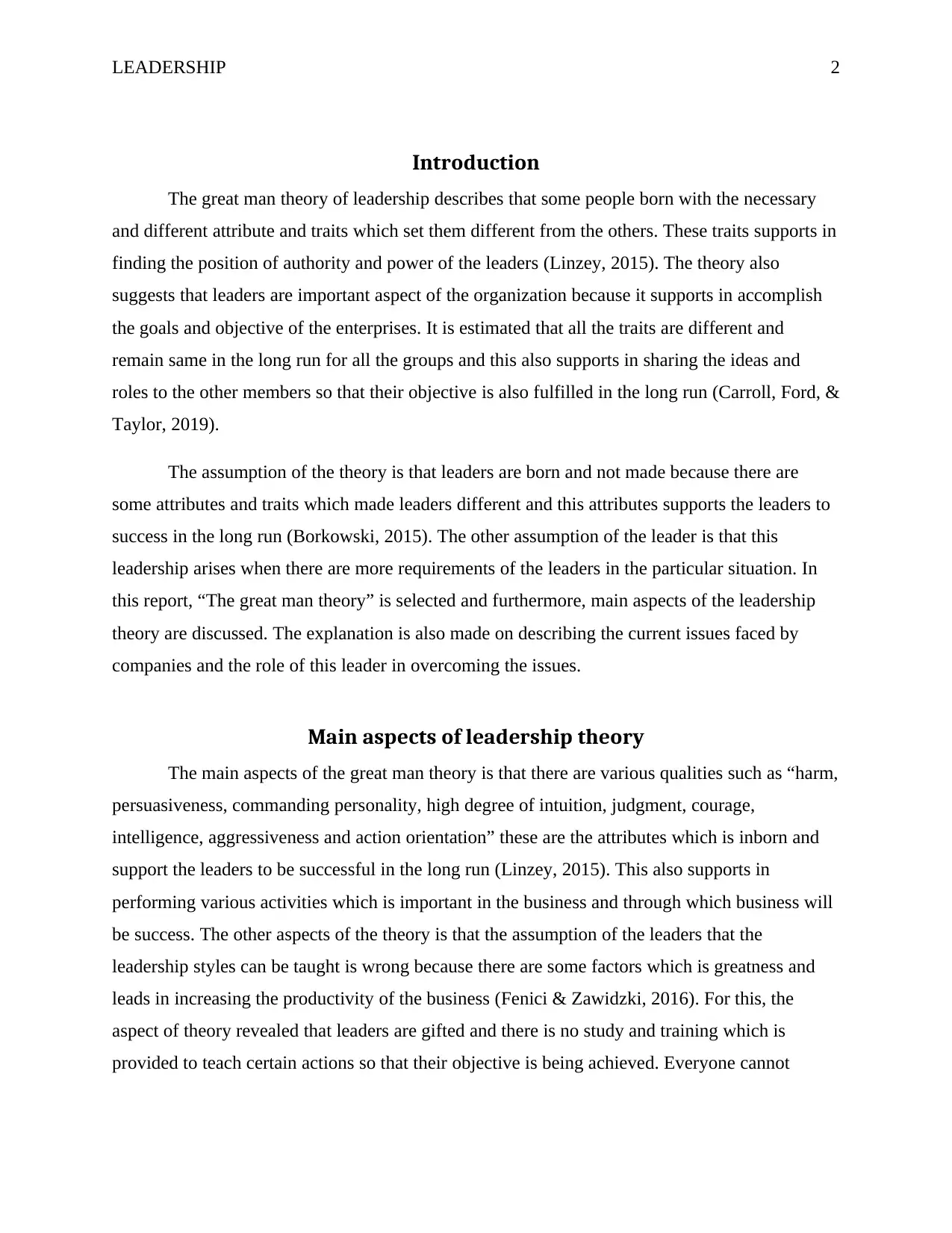
LEADERSHIP 2
Introduction
The great man theory of leadership describes that some people born with the necessary
and different attribute and traits which set them different from the others. These traits supports in
finding the position of authority and power of the leaders (Linzey, 2015). The theory also
suggests that leaders are important aspect of the organization because it supports in accomplish
the goals and objective of the enterprises. It is estimated that all the traits are different and
remain same in the long run for all the groups and this also supports in sharing the ideas and
roles to the other members so that their objective is also fulfilled in the long run (Carroll, Ford, &
Taylor, 2019).
The assumption of the theory is that leaders are born and not made because there are
some attributes and traits which made leaders different and this attributes supports the leaders to
success in the long run (Borkowski, 2015). The other assumption of the leader is that this
leadership arises when there are more requirements of the leaders in the particular situation. In
this report, “The great man theory” is selected and furthermore, main aspects of the leadership
theory are discussed. The explanation is also made on describing the current issues faced by
companies and the role of this leader in overcoming the issues.
Main aspects of leadership theory
The main aspects of the great man theory is that there are various qualities such as “harm,
persuasiveness, commanding personality, high degree of intuition, judgment, courage,
intelligence, aggressiveness and action orientation” these are the attributes which is inborn and
support the leaders to be successful in the long run (Linzey, 2015). This also supports in
performing various activities which is important in the business and through which business will
be success. The other aspects of the theory is that the assumption of the leaders that the
leadership styles can be taught is wrong because there are some factors which is greatness and
leads in increasing the productivity of the business (Fenici & Zawidzki, 2016). For this, the
aspect of theory revealed that leaders are gifted and there is no study and training which is
provided to teach certain actions so that their objective is being achieved. Everyone cannot
Introduction
The great man theory of leadership describes that some people born with the necessary
and different attribute and traits which set them different from the others. These traits supports in
finding the position of authority and power of the leaders (Linzey, 2015). The theory also
suggests that leaders are important aspect of the organization because it supports in accomplish
the goals and objective of the enterprises. It is estimated that all the traits are different and
remain same in the long run for all the groups and this also supports in sharing the ideas and
roles to the other members so that their objective is also fulfilled in the long run (Carroll, Ford, &
Taylor, 2019).
The assumption of the theory is that leaders are born and not made because there are
some attributes and traits which made leaders different and this attributes supports the leaders to
success in the long run (Borkowski, 2015). The other assumption of the leader is that this
leadership arises when there are more requirements of the leaders in the particular situation. In
this report, “The great man theory” is selected and furthermore, main aspects of the leadership
theory are discussed. The explanation is also made on describing the current issues faced by
companies and the role of this leader in overcoming the issues.
Main aspects of leadership theory
The main aspects of the great man theory is that there are various qualities such as “harm,
persuasiveness, commanding personality, high degree of intuition, judgment, courage,
intelligence, aggressiveness and action orientation” these are the attributes which is inborn and
support the leaders to be successful in the long run (Linzey, 2015). This also supports in
performing various activities which is important in the business and through which business will
be success. The other aspects of the theory is that the assumption of the leaders that the
leadership styles can be taught is wrong because there are some factors which is greatness and
leads in increasing the productivity of the business (Fenici & Zawidzki, 2016). For this, the
aspect of theory revealed that leaders are gifted and there is no study and training which is
provided to teach certain actions so that their objective is being achieved. Everyone cannot
⊘ This is a preview!⊘
Do you want full access?
Subscribe today to unlock all pages.

Trusted by 1+ million students worldwide
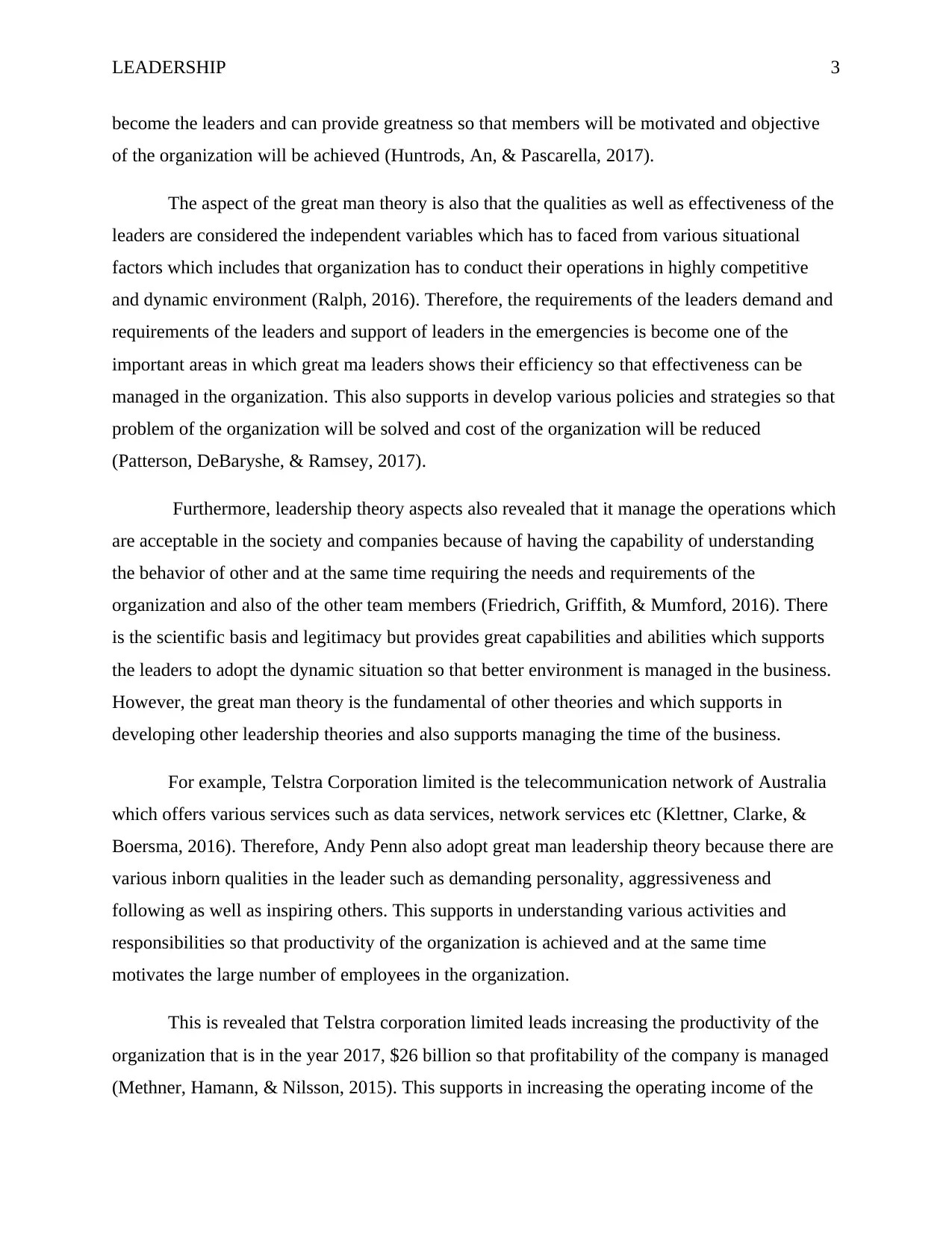
LEADERSHIP 3
become the leaders and can provide greatness so that members will be motivated and objective
of the organization will be achieved (Huntrods, An, & Pascarella, 2017).
The aspect of the great man theory is also that the qualities as well as effectiveness of the
leaders are considered the independent variables which has to faced from various situational
factors which includes that organization has to conduct their operations in highly competitive
and dynamic environment (Ralph, 2016). Therefore, the requirements of the leaders demand and
requirements of the leaders and support of leaders in the emergencies is become one of the
important areas in which great ma leaders shows their efficiency so that effectiveness can be
managed in the organization. This also supports in develop various policies and strategies so that
problem of the organization will be solved and cost of the organization will be reduced
(Patterson, DeBaryshe, & Ramsey, 2017).
Furthermore, leadership theory aspects also revealed that it manage the operations which
are acceptable in the society and companies because of having the capability of understanding
the behavior of other and at the same time requiring the needs and requirements of the
organization and also of the other team members (Friedrich, Griffith, & Mumford, 2016). There
is the scientific basis and legitimacy but provides great capabilities and abilities which supports
the leaders to adopt the dynamic situation so that better environment is managed in the business.
However, the great man theory is the fundamental of other theories and which supports in
developing other leadership theories and also supports managing the time of the business.
For example, Telstra Corporation limited is the telecommunication network of Australia
which offers various services such as data services, network services etc (Klettner, Clarke, &
Boersma, 2016). Therefore, Andy Penn also adopt great man leadership theory because there are
various inborn qualities in the leader such as demanding personality, aggressiveness and
following as well as inspiring others. This supports in understanding various activities and
responsibilities so that productivity of the organization is achieved and at the same time
motivates the large number of employees in the organization.
This is revealed that Telstra corporation limited leads increasing the productivity of the
organization that is in the year 2017, $26 billion so that profitability of the company is managed
(Methner, Hamann, & Nilsson, 2015). This supports in increasing the operating income of the
become the leaders and can provide greatness so that members will be motivated and objective
of the organization will be achieved (Huntrods, An, & Pascarella, 2017).
The aspect of the great man theory is also that the qualities as well as effectiveness of the
leaders are considered the independent variables which has to faced from various situational
factors which includes that organization has to conduct their operations in highly competitive
and dynamic environment (Ralph, 2016). Therefore, the requirements of the leaders demand and
requirements of the leaders and support of leaders in the emergencies is become one of the
important areas in which great ma leaders shows their efficiency so that effectiveness can be
managed in the organization. This also supports in develop various policies and strategies so that
problem of the organization will be solved and cost of the organization will be reduced
(Patterson, DeBaryshe, & Ramsey, 2017).
Furthermore, leadership theory aspects also revealed that it manage the operations which
are acceptable in the society and companies because of having the capability of understanding
the behavior of other and at the same time requiring the needs and requirements of the
organization and also of the other team members (Friedrich, Griffith, & Mumford, 2016). There
is the scientific basis and legitimacy but provides great capabilities and abilities which supports
the leaders to adopt the dynamic situation so that better environment is managed in the business.
However, the great man theory is the fundamental of other theories and which supports in
developing other leadership theories and also supports managing the time of the business.
For example, Telstra Corporation limited is the telecommunication network of Australia
which offers various services such as data services, network services etc (Klettner, Clarke, &
Boersma, 2016). Therefore, Andy Penn also adopt great man leadership theory because there are
various inborn qualities in the leader such as demanding personality, aggressiveness and
following as well as inspiring others. This supports in understanding various activities and
responsibilities so that productivity of the organization is achieved and at the same time
motivates the large number of employees in the organization.
This is revealed that Telstra corporation limited leads increasing the productivity of the
organization that is in the year 2017, $26 billion so that profitability of the company is managed
(Methner, Hamann, & Nilsson, 2015). This supports in increasing the operating income of the
Paraphrase This Document
Need a fresh take? Get an instant paraphrase of this document with our AI Paraphraser
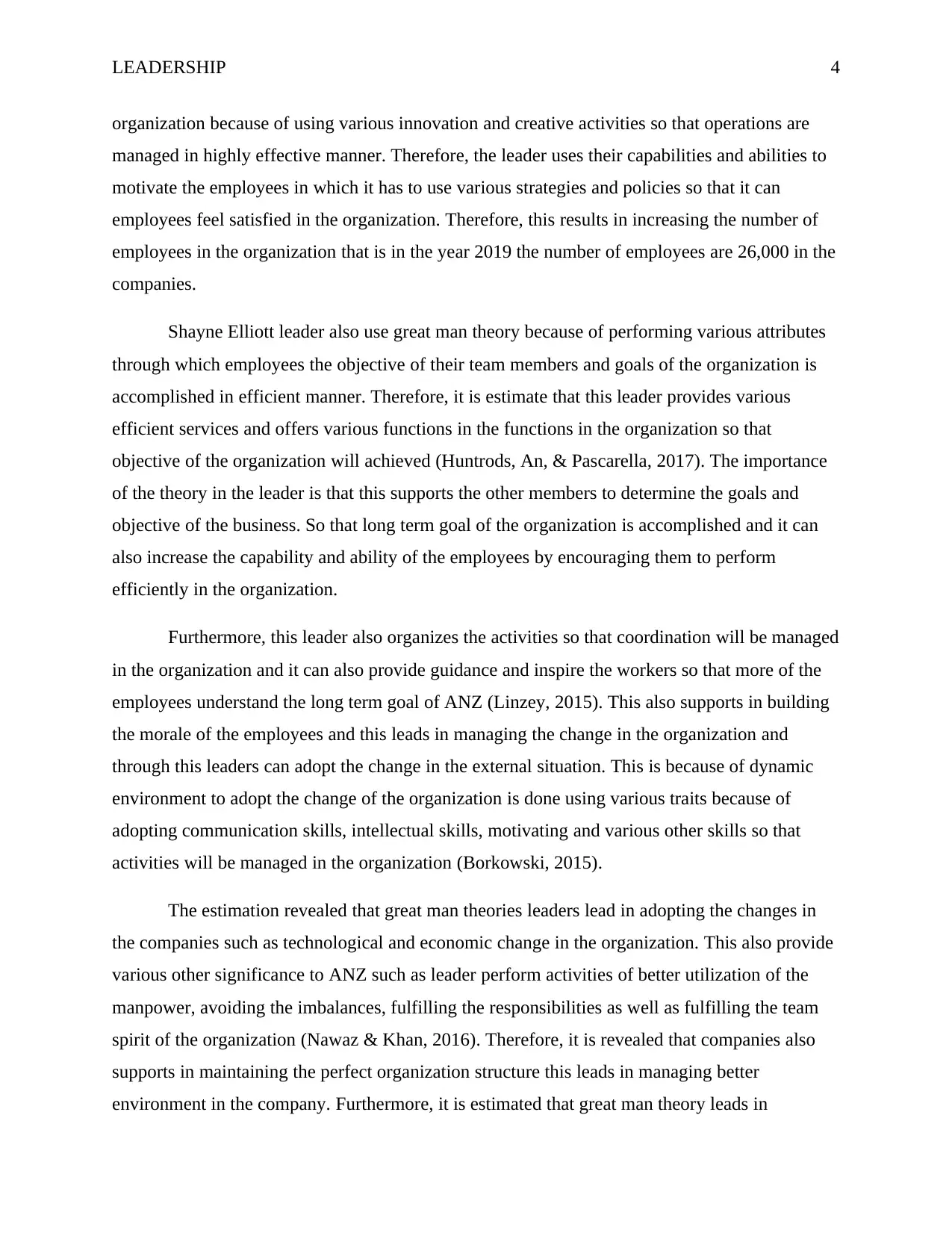
LEADERSHIP 4
organization because of using various innovation and creative activities so that operations are
managed in highly effective manner. Therefore, the leader uses their capabilities and abilities to
motivate the employees in which it has to use various strategies and policies so that it can
employees feel satisfied in the organization. Therefore, this results in increasing the number of
employees in the organization that is in the year 2019 the number of employees are 26,000 in the
companies.
Shayne Elliott leader also use great man theory because of performing various attributes
through which employees the objective of their team members and goals of the organization is
accomplished in efficient manner. Therefore, it is estimate that this leader provides various
efficient services and offers various functions in the functions in the organization so that
objective of the organization will achieved (Huntrods, An, & Pascarella, 2017). The importance
of the theory in the leader is that this supports the other members to determine the goals and
objective of the business. So that long term goal of the organization is accomplished and it can
also increase the capability and ability of the employees by encouraging them to perform
efficiently in the organization.
Furthermore, this leader also organizes the activities so that coordination will be managed
in the organization and it can also provide guidance and inspire the workers so that more of the
employees understand the long term goal of ANZ (Linzey, 2015). This also supports in building
the morale of the employees and this leads in managing the change in the organization and
through this leaders can adopt the change in the external situation. This is because of dynamic
environment to adopt the change of the organization is done using various traits because of
adopting communication skills, intellectual skills, motivating and various other skills so that
activities will be managed in the organization (Borkowski, 2015).
The estimation revealed that great man theories leaders lead in adopting the changes in
the companies such as technological and economic change in the organization. This also provide
various other significance to ANZ such as leader perform activities of better utilization of the
manpower, avoiding the imbalances, fulfilling the responsibilities as well as fulfilling the team
spirit of the organization (Nawaz & Khan, 2016). Therefore, it is revealed that companies also
supports in maintaining the perfect organization structure this leads in managing better
environment in the company. Furthermore, it is estimated that great man theory leads in
organization because of using various innovation and creative activities so that operations are
managed in highly effective manner. Therefore, the leader uses their capabilities and abilities to
motivate the employees in which it has to use various strategies and policies so that it can
employees feel satisfied in the organization. Therefore, this results in increasing the number of
employees in the organization that is in the year 2019 the number of employees are 26,000 in the
companies.
Shayne Elliott leader also use great man theory because of performing various attributes
through which employees the objective of their team members and goals of the organization is
accomplished in efficient manner. Therefore, it is estimate that this leader provides various
efficient services and offers various functions in the functions in the organization so that
objective of the organization will achieved (Huntrods, An, & Pascarella, 2017). The importance
of the theory in the leader is that this supports the other members to determine the goals and
objective of the business. So that long term goal of the organization is accomplished and it can
also increase the capability and ability of the employees by encouraging them to perform
efficiently in the organization.
Furthermore, this leader also organizes the activities so that coordination will be managed
in the organization and it can also provide guidance and inspire the workers so that more of the
employees understand the long term goal of ANZ (Linzey, 2015). This also supports in building
the morale of the employees and this leads in managing the change in the organization and
through this leaders can adopt the change in the external situation. This is because of dynamic
environment to adopt the change of the organization is done using various traits because of
adopting communication skills, intellectual skills, motivating and various other skills so that
activities will be managed in the organization (Borkowski, 2015).
The estimation revealed that great man theories leaders lead in adopting the changes in
the companies such as technological and economic change in the organization. This also provide
various other significance to ANZ such as leader perform activities of better utilization of the
manpower, avoiding the imbalances, fulfilling the responsibilities as well as fulfilling the team
spirit of the organization (Nawaz & Khan, 2016). Therefore, it is revealed that companies also
supports in maintaining the perfect organization structure this leads in managing better
environment in the company. Furthermore, it is estimated that great man theory leads in
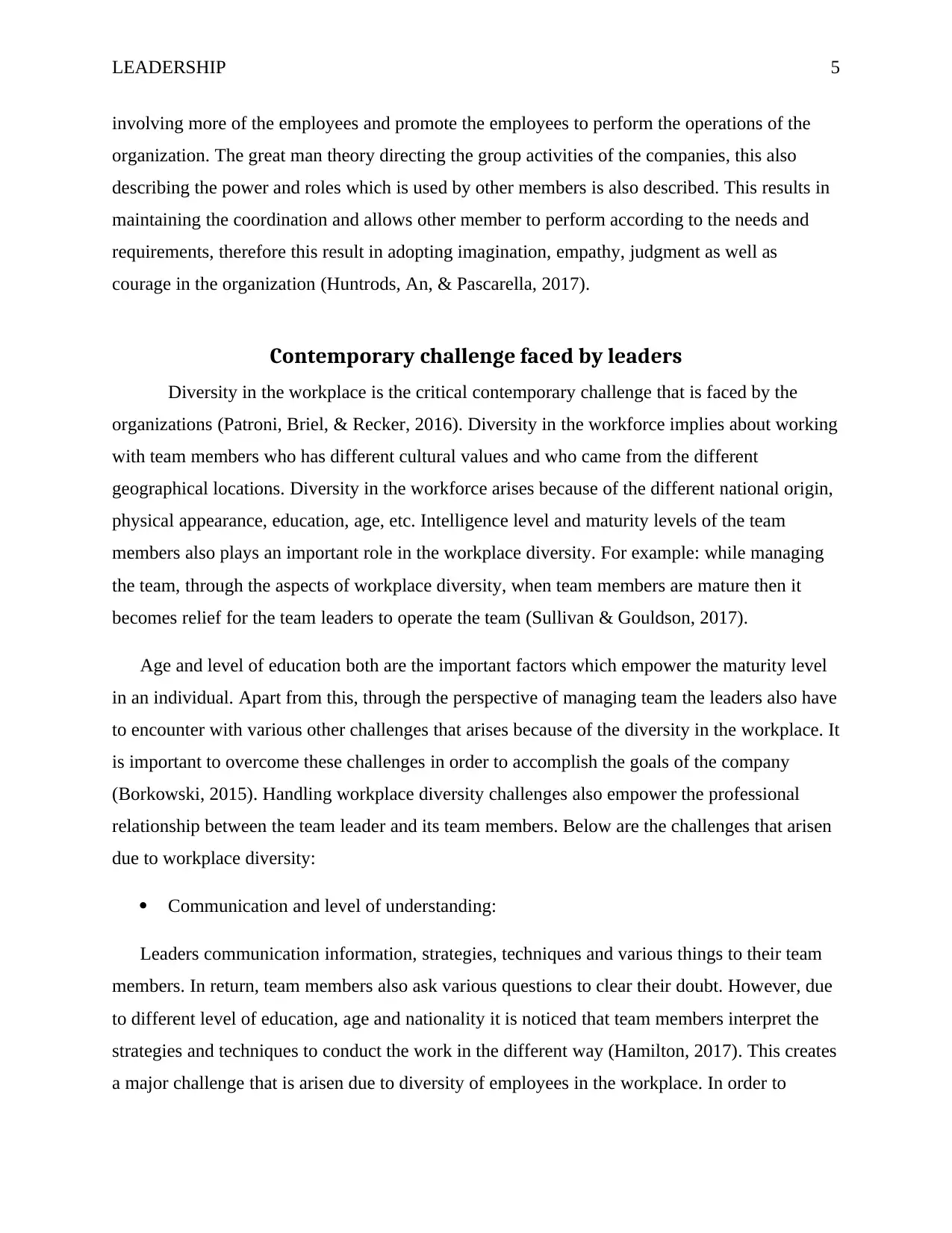
LEADERSHIP 5
involving more of the employees and promote the employees to perform the operations of the
organization. The great man theory directing the group activities of the companies, this also
describing the power and roles which is used by other members is also described. This results in
maintaining the coordination and allows other member to perform according to the needs and
requirements, therefore this result in adopting imagination, empathy, judgment as well as
courage in the organization (Huntrods, An, & Pascarella, 2017).
Contemporary challenge faced by leaders
Diversity in the workplace is the critical contemporary challenge that is faced by the
organizations (Patroni, Briel, & Recker, 2016). Diversity in the workforce implies about working
with team members who has different cultural values and who came from the different
geographical locations. Diversity in the workforce arises because of the different national origin,
physical appearance, education, age, etc. Intelligence level and maturity levels of the team
members also plays an important role in the workplace diversity. For example: while managing
the team, through the aspects of workplace diversity, when team members are mature then it
becomes relief for the team leaders to operate the team (Sullivan & Gouldson, 2017).
Age and level of education both are the important factors which empower the maturity level
in an individual. Apart from this, through the perspective of managing team the leaders also have
to encounter with various other challenges that arises because of the diversity in the workplace. It
is important to overcome these challenges in order to accomplish the goals of the company
(Borkowski, 2015). Handling workplace diversity challenges also empower the professional
relationship between the team leader and its team members. Below are the challenges that arisen
due to workplace diversity:
Communication and level of understanding:
Leaders communication information, strategies, techniques and various things to their team
members. In return, team members also ask various questions to clear their doubt. However, due
to different level of education, age and nationality it is noticed that team members interpret the
strategies and techniques to conduct the work in the different way (Hamilton, 2017). This creates
a major challenge that is arisen due to diversity of employees in the workplace. In order to
involving more of the employees and promote the employees to perform the operations of the
organization. The great man theory directing the group activities of the companies, this also
describing the power and roles which is used by other members is also described. This results in
maintaining the coordination and allows other member to perform according to the needs and
requirements, therefore this result in adopting imagination, empathy, judgment as well as
courage in the organization (Huntrods, An, & Pascarella, 2017).
Contemporary challenge faced by leaders
Diversity in the workplace is the critical contemporary challenge that is faced by the
organizations (Patroni, Briel, & Recker, 2016). Diversity in the workforce implies about working
with team members who has different cultural values and who came from the different
geographical locations. Diversity in the workforce arises because of the different national origin,
physical appearance, education, age, etc. Intelligence level and maturity levels of the team
members also plays an important role in the workplace diversity. For example: while managing
the team, through the aspects of workplace diversity, when team members are mature then it
becomes relief for the team leaders to operate the team (Sullivan & Gouldson, 2017).
Age and level of education both are the important factors which empower the maturity level
in an individual. Apart from this, through the perspective of managing team the leaders also have
to encounter with various other challenges that arises because of the diversity in the workplace. It
is important to overcome these challenges in order to accomplish the goals of the company
(Borkowski, 2015). Handling workplace diversity challenges also empower the professional
relationship between the team leader and its team members. Below are the challenges that arisen
due to workplace diversity:
Communication and level of understanding:
Leaders communication information, strategies, techniques and various things to their team
members. In return, team members also ask various questions to clear their doubt. However, due
to different level of education, age and nationality it is noticed that team members interpret the
strategies and techniques to conduct the work in the different way (Hamilton, 2017). This creates
a major challenge that is arisen due to diversity of employees in the workplace. In order to
⊘ This is a preview!⊘
Do you want full access?
Subscribe today to unlock all pages.

Trusted by 1+ million students worldwide
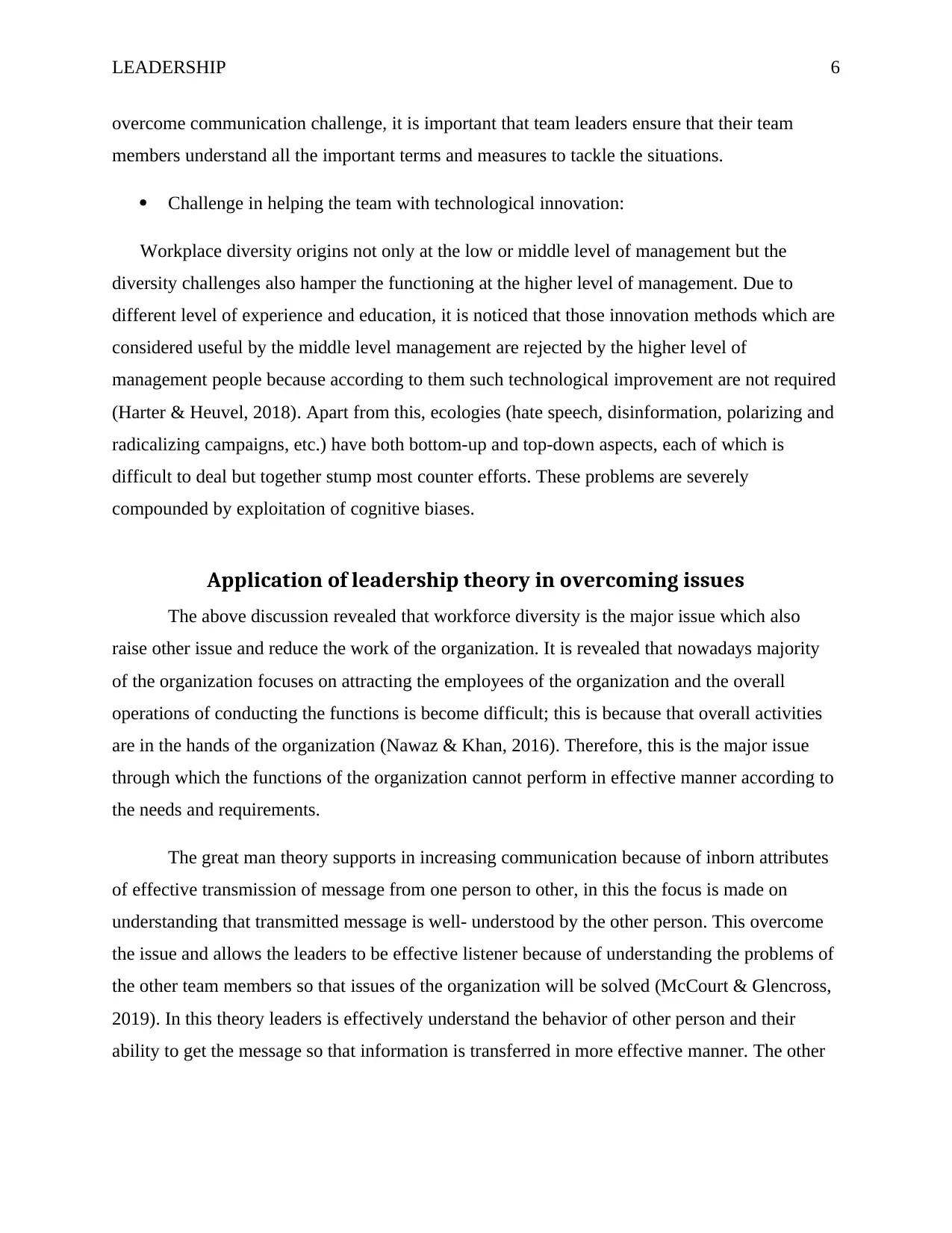
LEADERSHIP 6
overcome communication challenge, it is important that team leaders ensure that their team
members understand all the important terms and measures to tackle the situations.
Challenge in helping the team with technological innovation:
Workplace diversity origins not only at the low or middle level of management but the
diversity challenges also hamper the functioning at the higher level of management. Due to
different level of experience and education, it is noticed that those innovation methods which are
considered useful by the middle level management are rejected by the higher level of
management people because according to them such technological improvement are not required
(Harter & Heuvel, 2018). Apart from this, ecologies (hate speech, disinformation, polarizing and
radicalizing campaigns, etc.) have both bottom-up and top-down aspects, each of which is
difficult to deal but together stump most counter efforts. These problems are severely
compounded by exploitation of cognitive biases.
Application of leadership theory in overcoming issues
The above discussion revealed that workforce diversity is the major issue which also
raise other issue and reduce the work of the organization. It is revealed that nowadays majority
of the organization focuses on attracting the employees of the organization and the overall
operations of conducting the functions is become difficult; this is because that overall activities
are in the hands of the organization (Nawaz & Khan, 2016). Therefore, this is the major issue
through which the functions of the organization cannot perform in effective manner according to
the needs and requirements.
The great man theory supports in increasing communication because of inborn attributes
of effective transmission of message from one person to other, in this the focus is made on
understanding that transmitted message is well- understood by the other person. This overcome
the issue and allows the leaders to be effective listener because of understanding the problems of
the other team members so that issues of the organization will be solved (McCourt & Glencross,
2019). In this theory leaders is effectively understand the behavior of other person and their
ability to get the message so that information is transferred in more effective manner. The other
overcome communication challenge, it is important that team leaders ensure that their team
members understand all the important terms and measures to tackle the situations.
Challenge in helping the team with technological innovation:
Workplace diversity origins not only at the low or middle level of management but the
diversity challenges also hamper the functioning at the higher level of management. Due to
different level of experience and education, it is noticed that those innovation methods which are
considered useful by the middle level management are rejected by the higher level of
management people because according to them such technological improvement are not required
(Harter & Heuvel, 2018). Apart from this, ecologies (hate speech, disinformation, polarizing and
radicalizing campaigns, etc.) have both bottom-up and top-down aspects, each of which is
difficult to deal but together stump most counter efforts. These problems are severely
compounded by exploitation of cognitive biases.
Application of leadership theory in overcoming issues
The above discussion revealed that workforce diversity is the major issue which also
raise other issue and reduce the work of the organization. It is revealed that nowadays majority
of the organization focuses on attracting the employees of the organization and the overall
operations of conducting the functions is become difficult; this is because that overall activities
are in the hands of the organization (Nawaz & Khan, 2016). Therefore, this is the major issue
through which the functions of the organization cannot perform in effective manner according to
the needs and requirements.
The great man theory supports in increasing communication because of inborn attributes
of effective transmission of message from one person to other, in this the focus is made on
understanding that transmitted message is well- understood by the other person. This overcome
the issue and allows the leaders to be effective listener because of understanding the problems of
the other team members so that issues of the organization will be solved (McCourt & Glencross,
2019). In this theory leaders is effectively understand the behavior of other person and their
ability to get the message so that information is transferred in more effective manner. The other
Paraphrase This Document
Need a fresh take? Get an instant paraphrase of this document with our AI Paraphraser
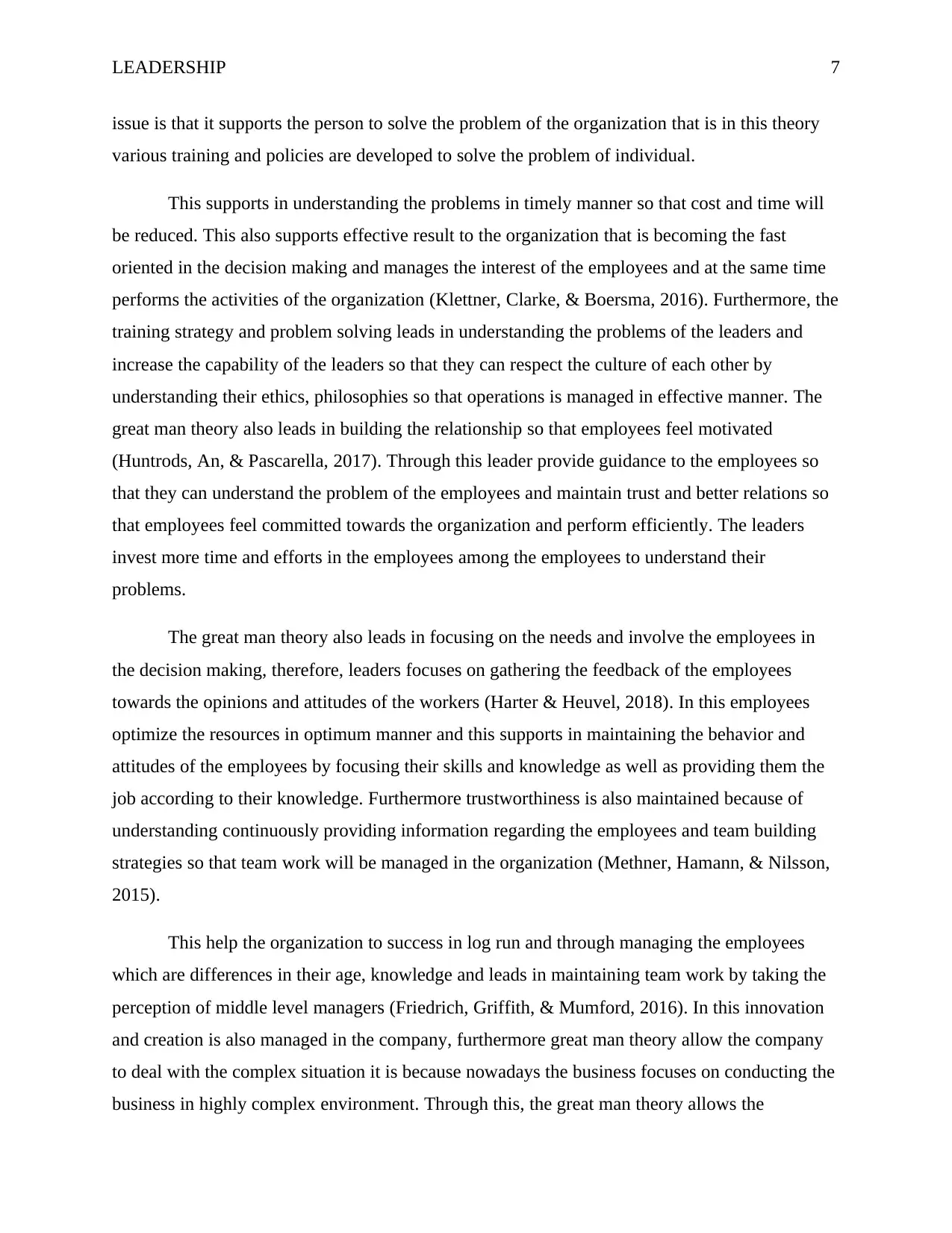
LEADERSHIP 7
issue is that it supports the person to solve the problem of the organization that is in this theory
various training and policies are developed to solve the problem of individual.
This supports in understanding the problems in timely manner so that cost and time will
be reduced. This also supports effective result to the organization that is becoming the fast
oriented in the decision making and manages the interest of the employees and at the same time
performs the activities of the organization (Klettner, Clarke, & Boersma, 2016). Furthermore, the
training strategy and problem solving leads in understanding the problems of the leaders and
increase the capability of the leaders so that they can respect the culture of each other by
understanding their ethics, philosophies so that operations is managed in effective manner. The
great man theory also leads in building the relationship so that employees feel motivated
(Huntrods, An, & Pascarella, 2017). Through this leader provide guidance to the employees so
that they can understand the problem of the employees and maintain trust and better relations so
that employees feel committed towards the organization and perform efficiently. The leaders
invest more time and efforts in the employees among the employees to understand their
problems.
The great man theory also leads in focusing on the needs and involve the employees in
the decision making, therefore, leaders focuses on gathering the feedback of the employees
towards the opinions and attitudes of the workers (Harter & Heuvel, 2018). In this employees
optimize the resources in optimum manner and this supports in maintaining the behavior and
attitudes of the employees by focusing their skills and knowledge as well as providing them the
job according to their knowledge. Furthermore trustworthiness is also maintained because of
understanding continuously providing information regarding the employees and team building
strategies so that team work will be managed in the organization (Methner, Hamann, & Nilsson,
2015).
This help the organization to success in log run and through managing the employees
which are differences in their age, knowledge and leads in maintaining team work by taking the
perception of middle level managers (Friedrich, Griffith, & Mumford, 2016). In this innovation
and creation is also managed in the company, furthermore great man theory allow the company
to deal with the complex situation it is because nowadays the business focuses on conducting the
business in highly complex environment. Through this, the great man theory allows the
issue is that it supports the person to solve the problem of the organization that is in this theory
various training and policies are developed to solve the problem of individual.
This supports in understanding the problems in timely manner so that cost and time will
be reduced. This also supports effective result to the organization that is becoming the fast
oriented in the decision making and manages the interest of the employees and at the same time
performs the activities of the organization (Klettner, Clarke, & Boersma, 2016). Furthermore, the
training strategy and problem solving leads in understanding the problems of the leaders and
increase the capability of the leaders so that they can respect the culture of each other by
understanding their ethics, philosophies so that operations is managed in effective manner. The
great man theory also leads in building the relationship so that employees feel motivated
(Huntrods, An, & Pascarella, 2017). Through this leader provide guidance to the employees so
that they can understand the problem of the employees and maintain trust and better relations so
that employees feel committed towards the organization and perform efficiently. The leaders
invest more time and efforts in the employees among the employees to understand their
problems.
The great man theory also leads in focusing on the needs and involve the employees in
the decision making, therefore, leaders focuses on gathering the feedback of the employees
towards the opinions and attitudes of the workers (Harter & Heuvel, 2018). In this employees
optimize the resources in optimum manner and this supports in maintaining the behavior and
attitudes of the employees by focusing their skills and knowledge as well as providing them the
job according to their knowledge. Furthermore trustworthiness is also maintained because of
understanding continuously providing information regarding the employees and team building
strategies so that team work will be managed in the organization (Methner, Hamann, & Nilsson,
2015).
This help the organization to success in log run and through managing the employees
which are differences in their age, knowledge and leads in maintaining team work by taking the
perception of middle level managers (Friedrich, Griffith, & Mumford, 2016). In this innovation
and creation is also managed in the company, furthermore great man theory allow the company
to deal with the complex situation it is because nowadays the business focuses on conducting the
business in highly complex environment. Through this, the great man theory allows the
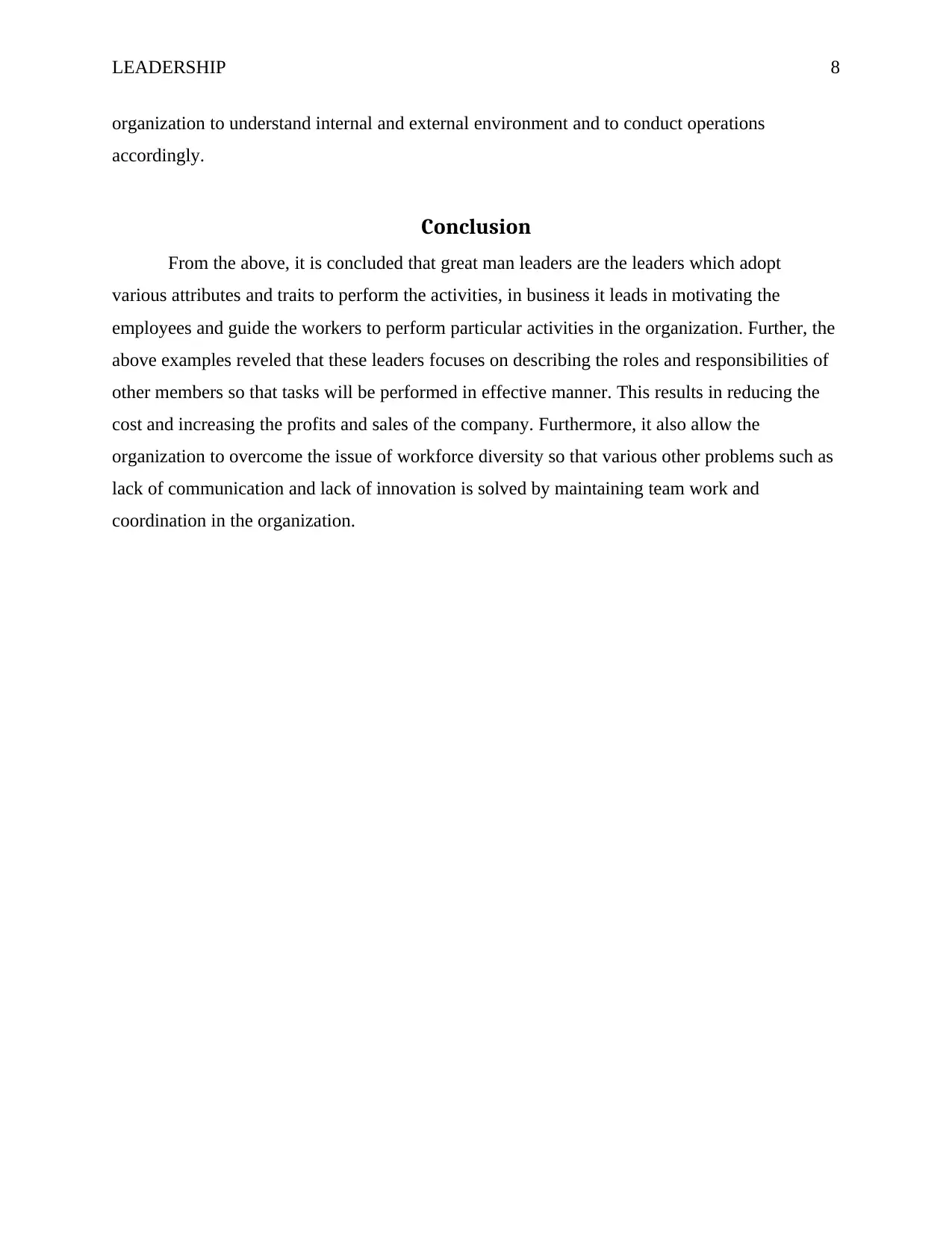
LEADERSHIP 8
organization to understand internal and external environment and to conduct operations
accordingly.
Conclusion
From the above, it is concluded that great man leaders are the leaders which adopt
various attributes and traits to perform the activities, in business it leads in motivating the
employees and guide the workers to perform particular activities in the organization. Further, the
above examples reveled that these leaders focuses on describing the roles and responsibilities of
other members so that tasks will be performed in effective manner. This results in reducing the
cost and increasing the profits and sales of the company. Furthermore, it also allow the
organization to overcome the issue of workforce diversity so that various other problems such as
lack of communication and lack of innovation is solved by maintaining team work and
coordination in the organization.
organization to understand internal and external environment and to conduct operations
accordingly.
Conclusion
From the above, it is concluded that great man leaders are the leaders which adopt
various attributes and traits to perform the activities, in business it leads in motivating the
employees and guide the workers to perform particular activities in the organization. Further, the
above examples reveled that these leaders focuses on describing the roles and responsibilities of
other members so that tasks will be performed in effective manner. This results in reducing the
cost and increasing the profits and sales of the company. Furthermore, it also allow the
organization to overcome the issue of workforce diversity so that various other problems such as
lack of communication and lack of innovation is solved by maintaining team work and
coordination in the organization.
⊘ This is a preview!⊘
Do you want full access?
Subscribe today to unlock all pages.

Trusted by 1+ million students worldwide
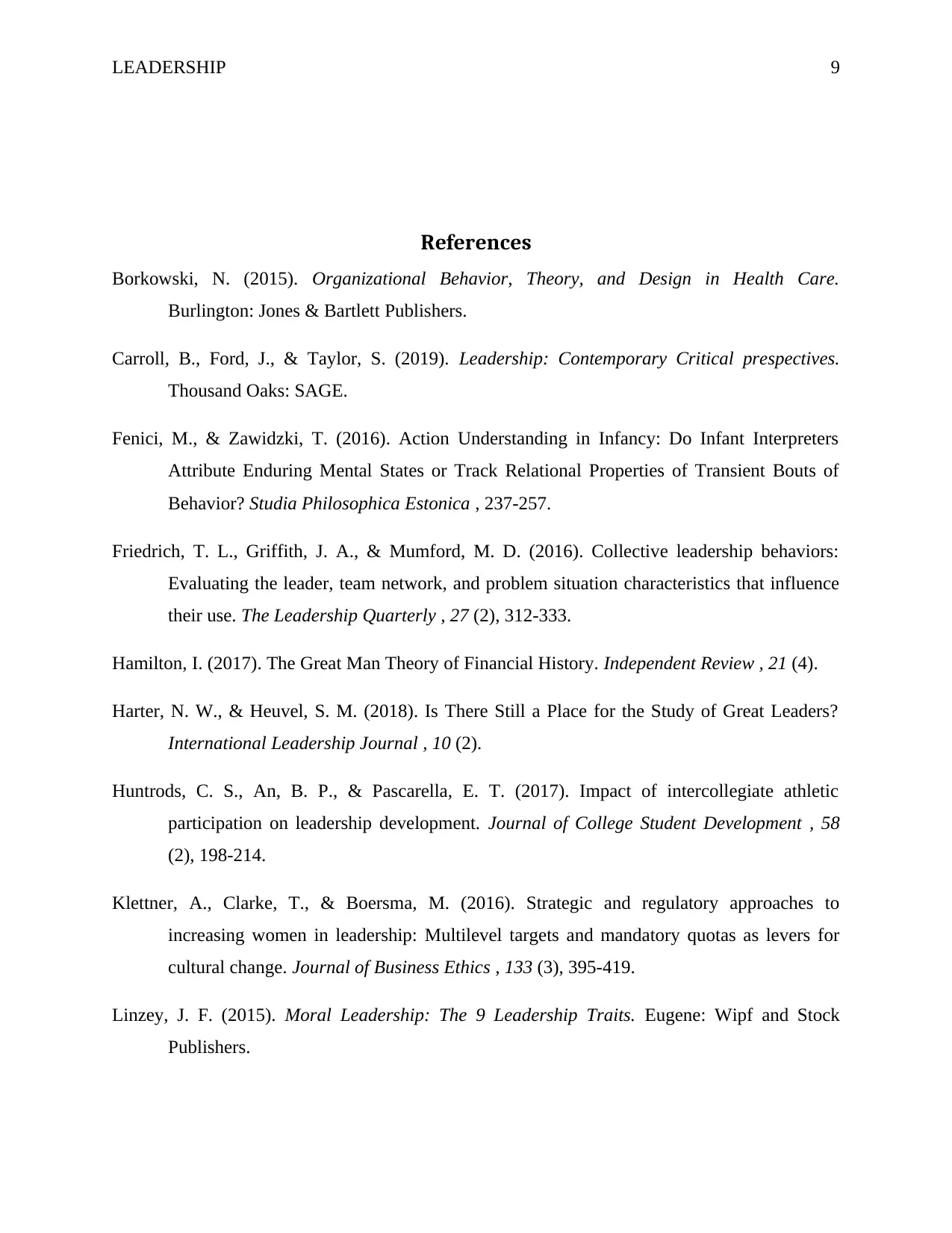
LEADERSHIP 9
References
Borkowski, N. (2015). Organizational Behavior, Theory, and Design in Health Care.
Burlington: Jones & Bartlett Publishers.
Carroll, B., Ford, J., & Taylor, S. (2019). Leadership: Contemporary Critical prespectives.
Thousand Oaks: SAGE.
Fenici, M., & Zawidzki, T. (2016). Action Understanding in Infancy: Do Infant Interpreters
Attribute Enduring Mental States or Track Relational Properties of Transient Bouts of
Behavior? Studia Philosophica Estonica , 237-257.
Friedrich, T. L., Griffith, J. A., & Mumford, M. D. (2016). Collective leadership behaviors:
Evaluating the leader, team network, and problem situation characteristics that influence
their use. The Leadership Quarterly , 27 (2), 312-333.
Hamilton, I. (2017). The Great Man Theory of Financial History. Independent Review , 21 (4).
Harter, N. W., & Heuvel, S. M. (2018). Is There Still a Place for the Study of Great Leaders?
International Leadership Journal , 10 (2).
Huntrods, C. S., An, B. P., & Pascarella, E. T. (2017). Impact of intercollegiate athletic
participation on leadership development. Journal of College Student Development , 58
(2), 198-214.
Klettner, A., Clarke, T., & Boersma, M. (2016). Strategic and regulatory approaches to
increasing women in leadership: Multilevel targets and mandatory quotas as levers for
cultural change. Journal of Business Ethics , 133 (3), 395-419.
Linzey, J. F. (2015). Moral Leadership: The 9 Leadership Traits. Eugene: Wipf and Stock
Publishers.
References
Borkowski, N. (2015). Organizational Behavior, Theory, and Design in Health Care.
Burlington: Jones & Bartlett Publishers.
Carroll, B., Ford, J., & Taylor, S. (2019). Leadership: Contemporary Critical prespectives.
Thousand Oaks: SAGE.
Fenici, M., & Zawidzki, T. (2016). Action Understanding in Infancy: Do Infant Interpreters
Attribute Enduring Mental States or Track Relational Properties of Transient Bouts of
Behavior? Studia Philosophica Estonica , 237-257.
Friedrich, T. L., Griffith, J. A., & Mumford, M. D. (2016). Collective leadership behaviors:
Evaluating the leader, team network, and problem situation characteristics that influence
their use. The Leadership Quarterly , 27 (2), 312-333.
Hamilton, I. (2017). The Great Man Theory of Financial History. Independent Review , 21 (4).
Harter, N. W., & Heuvel, S. M. (2018). Is There Still a Place for the Study of Great Leaders?
International Leadership Journal , 10 (2).
Huntrods, C. S., An, B. P., & Pascarella, E. T. (2017). Impact of intercollegiate athletic
participation on leadership development. Journal of College Student Development , 58
(2), 198-214.
Klettner, A., Clarke, T., & Boersma, M. (2016). Strategic and regulatory approaches to
increasing women in leadership: Multilevel targets and mandatory quotas as levers for
cultural change. Journal of Business Ethics , 133 (3), 395-419.
Linzey, J. F. (2015). Moral Leadership: The 9 Leadership Traits. Eugene: Wipf and Stock
Publishers.
Paraphrase This Document
Need a fresh take? Get an instant paraphrase of this document with our AI Paraphraser
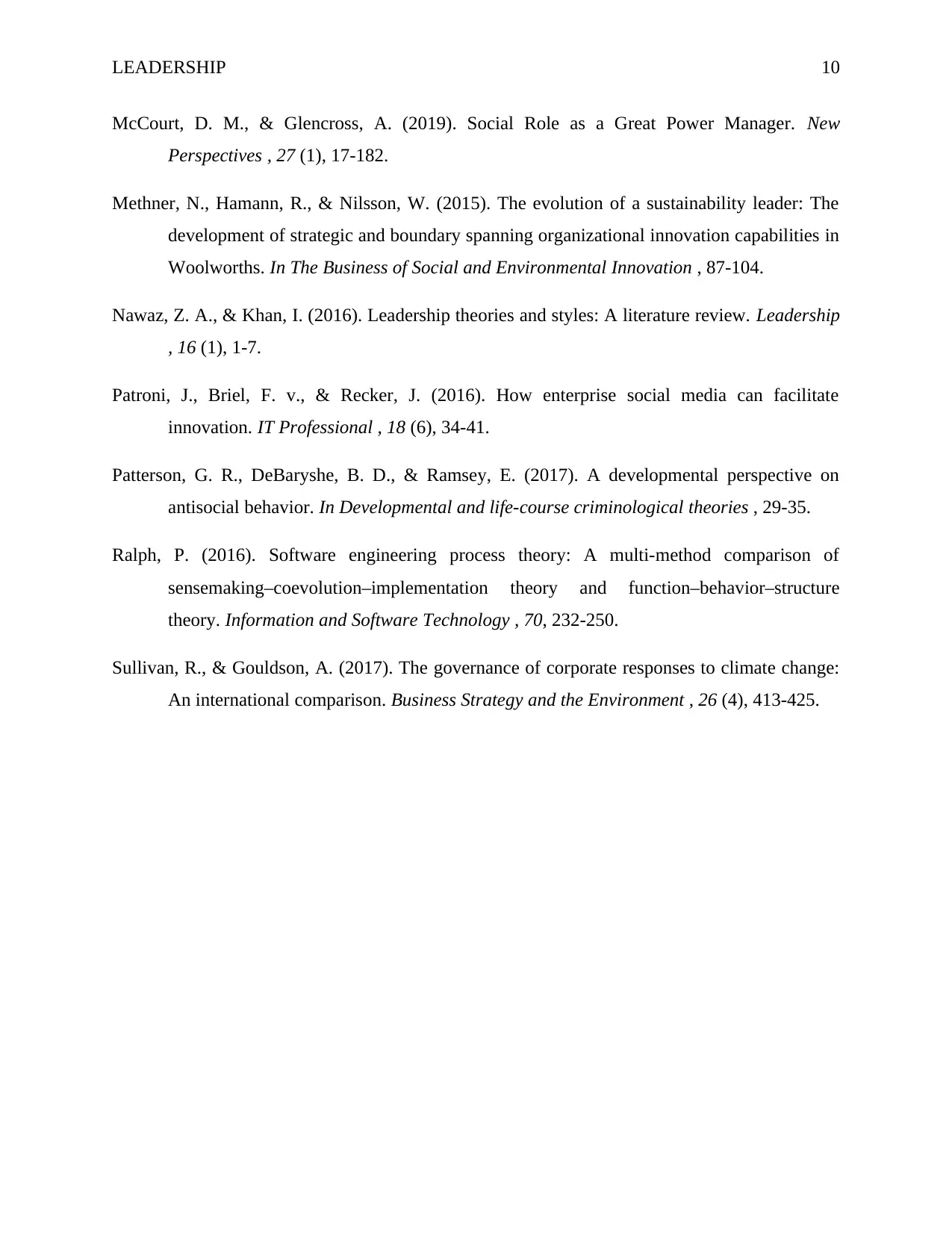
LEADERSHIP 10
McCourt, D. M., & Glencross, A. (2019). Social Role as a Great Power Manager. New
Perspectives , 27 (1), 17-182.
Methner, N., Hamann, R., & Nilsson, W. (2015). The evolution of a sustainability leader: The
development of strategic and boundary spanning organizational innovation capabilities in
Woolworths. In The Business of Social and Environmental Innovation , 87-104.
Nawaz, Z. A., & Khan, I. (2016). Leadership theories and styles: A literature review. Leadership
, 16 (1), 1-7.
Patroni, J., Briel, F. v., & Recker, J. (2016). How enterprise social media can facilitate
innovation. IT Professional , 18 (6), 34-41.
Patterson, G. R., DeBaryshe, B. D., & Ramsey, E. (2017). A developmental perspective on
antisocial behavior. In Developmental and life-course criminological theories , 29-35.
Ralph, P. (2016). Software engineering process theory: A multi-method comparison of
sensemaking–coevolution–implementation theory and function–behavior–structure
theory. Information and Software Technology , 70, 232-250.
Sullivan, R., & Gouldson, A. (2017). The governance of corporate responses to climate change:
An international comparison. Business Strategy and the Environment , 26 (4), 413-425.
McCourt, D. M., & Glencross, A. (2019). Social Role as a Great Power Manager. New
Perspectives , 27 (1), 17-182.
Methner, N., Hamann, R., & Nilsson, W. (2015). The evolution of a sustainability leader: The
development of strategic and boundary spanning organizational innovation capabilities in
Woolworths. In The Business of Social and Environmental Innovation , 87-104.
Nawaz, Z. A., & Khan, I. (2016). Leadership theories and styles: A literature review. Leadership
, 16 (1), 1-7.
Patroni, J., Briel, F. v., & Recker, J. (2016). How enterprise social media can facilitate
innovation. IT Professional , 18 (6), 34-41.
Patterson, G. R., DeBaryshe, B. D., & Ramsey, E. (2017). A developmental perspective on
antisocial behavior. In Developmental and life-course criminological theories , 29-35.
Ralph, P. (2016). Software engineering process theory: A multi-method comparison of
sensemaking–coevolution–implementation theory and function–behavior–structure
theory. Information and Software Technology , 70, 232-250.
Sullivan, R., & Gouldson, A. (2017). The governance of corporate responses to climate change:
An international comparison. Business Strategy and the Environment , 26 (4), 413-425.
1 out of 11
Related Documents
Your All-in-One AI-Powered Toolkit for Academic Success.
+13062052269
info@desklib.com
Available 24*7 on WhatsApp / Email
![[object Object]](/_next/static/media/star-bottom.7253800d.svg)
Unlock your academic potential
Copyright © 2020–2025 A2Z Services. All Rights Reserved. Developed and managed by ZUCOL.




